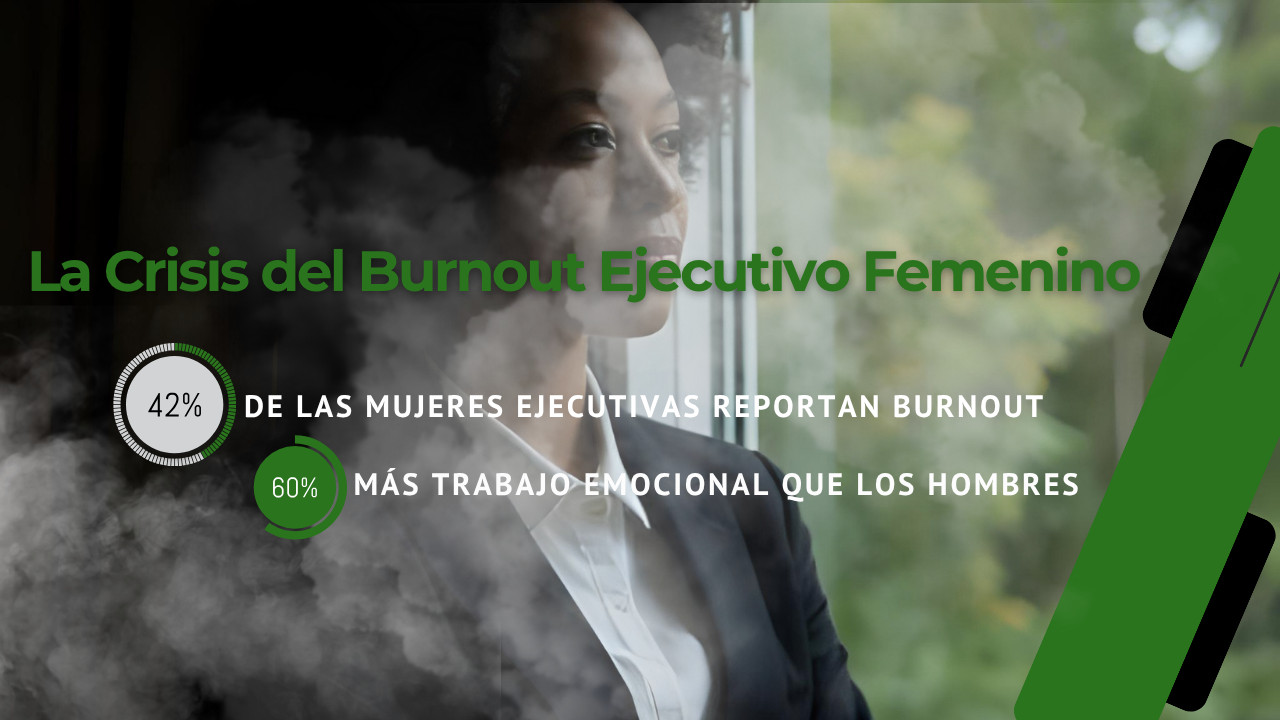
Last week, the CEO of a local company with around 400 employees said something that stuck with me:
“I lost my best VP of Operations because I missed the signs. She was our star, but burnout silently took her away. Now we’re paying twice as much to replace her.”
This isn’t the first time I’ve heard a story like this. Sadly, many come from Fortune 500 companies, where losing a VP of Operations can cost three times as much to replace, given the annual revenue they generate.
While companies invest millions in technology and processes, a silent crisis is eroding their most valuable asset: executive female leadership.
The numbers are striking and concerning:
42% of executive women report being completely burned out, according to McKinsey’s Women in the Workplace study. This is a significant increase from the previous year and notably higher than their male counterparts.
But here’s the data point every board of directors should be alarmed by: senior female leaders have done 60% more emotional labor to support their teams in recent years compared to men in similar positions.
They’re giving more. Receiving less recognition. And burning out faster.
How much does it really cost to lose a female executive to burnout?
The math is brutally simple:
Total cost: Between 150%–300% of that executive’s annual salary.
For a VP earning $200,000 annually, we’re talking about a total cost of $300,000–$600,000. Not to mention the missed opportunities and reputational damage.
Now, let’s contrast that with this reality:
Multinational Johnson & Johnson, where I worked in preventive wellness for employees for over 20 years, reported in a December 2010 Harvard Business Review study that it saved $250 million in healthcare costs over a decade thanks to its corporate wellness programs.
Their return: $2.71 for every $1 invested.
Well-designed wellness programs are not expenses; they’re strategic investments with a proven ROI of up to 6:1.
Recent research on executives who have participated in corporate retreats shows transformative results:
Moreover, studies from the Center for Creative Leadership confirm that leadership development programs—including retreats—result in a 25% increase in overall leadership skills.
These are not “feel-good metrics.”
They are direct business performance indicators.
Over my 25 years developing corporate wellness programs, I decided a year and a half ago to incorporate wellness retreats into my services—and I’ve witnessed extraordinary transformations.
I’ve seen executives return as renewed leaders, inspiring entire teams, other community members, and making decisions that positively impact financial outcomes.
Specialized wellness retreats for executive women are not “fancy spa days.”
Our retreats are strategic interventions that deliver transformational experiences—with a personalized journey, targeted focus, and specific audience.
What sets them apart is their immersive and experiential nature, as opposed to traditional workshops filled with dense content in brief formats. They are designed to:
I once heard a phrase that perfectly sums up our philosophy:
“Retreats are about embodiment, not just information.”
That’s exactly what sets our programs apart.
Is your company in prevention mode or replacement mode?
Replacement mode: You wait for executives to burn out and leave, then spend $300,000–$600,000 finding and training replacements—while losing institutional knowledge and damaging organizational morale.
Prevention mode: You invest strategically in executive wellness programs with proven 6:1 ROI, retain critical talent, and strengthen your leadership culture.
With 56% of leaders currently facing burnout, and executive women disproportionately affected, the cost of inaction continues to rise.
Smart companies no longer see executive wellness as a “nice-to-have.”
They recognize it for what it truly is: a strategic competitive advantage.
After decades in this field, I’ve learned one truth: Numbers don’t lie, but decisions are made by people.
If you’re a CEO, CHRO, or member of the executive board, I invite you to consider:
What is the real value of retaining your top female executive talent?
And how much are you willing to invest to protect that investment?
The data is clear.
The solutions exist.
The results are proven.
Only one thing is missing: a decision.
Is your organization ready to make the retention of executive female talent a strategic priority?
I’d love to hear your perspective in a direct conversation.
To all women leaders, here’s the Blueprint for the Professional Woman.

This is the story behind Immersion Restore and Revive-a path that transformed my losses into purpose.
My father’s departure at age 17 was the first loss that marked my path and left a void that stayed with me as I built a “successful” career by all external standards. MBA in hand, executive position in a Fortune 500-but internally, something fundamental was missing.
At a multinational, my professional life shone on paper but felt hollow. Until a kickboxing class ignited the first spark of reconnection with my body and my purpose.
The question that changed everything: Why not create from my own passion?
I left corporate security to found my wellness company, combining my executive experience with my passion for optimal human performance. For 20 years, I tried to change organizations from the outside, facing resistance and constantly questioning my path.
A contractual loss shook my financial and emotional stability. With my savings threatened and total uncertainty, I made the boldest decision; to invest a large amount of money in my training with Tony Robbins and other leaders to create something new.
At a retreat in the Fiji Islands, I found the missing piece: my losses were not obstacles but bridges to my true purpose.
At that retreat I met the owner of Villa Mahalo in Lanzarote (“mahalo” means gratitude in Hawaiian). This encounter catalyzed the creation of “Inmersión Restaura y Revive” with another extraordinary Puerto Rican expert in lifestyle medicine.
Like the volcanic landscapes that surround us in Lanzarote, where destruction has given way to a unique ecosystem of extraordinary beauty, our retreat offers a space where you will find inner peace, renewed clarity about professional and personal priorities, build connections with other leaders that transcend the professional and at the end, you will feel lighter, renewed and ready to make way for a more aligned, authentic and fulfilling life.
I invite you to join us and celebrate together the extraordinary leader you are destined to be.

Esta es la historia detrás de Inmersión Restaura y Revive—un camino que transformó mis pérdidas en propósito.
La partida de mi padre a los 17 años de edad, fue la primera pérdida que marcó mi camino y dejó un vacío que me acompañó mientras construía una carrera “exitosa” según todos los estándares externos. MBA en mano, posición ejecutiva en una Fortune 500—pero internamente, algo fundamental faltaba.
En una multinacional, mi vida profesional brillaba en papel pero se sentía hueca. Hasta que una clase de kickboxing encendió la primera chispa de reconexión con mi cuerpo y mi propósito.
La pregunta que cambió todo: ¿Por qué no crear desde mi propia pasión?
Dejé la seguridad corporativa para fundar mi empresa de bienestar, combinando mi experiencia ejecutiva con mi pasión por el rendimiento humano óptimo. Durante 20 años, intenté cambiar organizaciones desde afuera, enfrentando resistencias y cuestionando constantemente mi camino.
Una pérdida contractual sacudió mi estabilidad económica y emocional. Con mis ahorros amenazados e incertidumbre total, tomé la decisión más audaz; invertir una alta cantidad de dinero en mi formación con Tony Robbins y otros líderes para crear algo nuevo.
En un retiro en las Islas Fiji, encontré la pieza que faltaba: mis pérdidas no eran obstáculos sino puentes hacia mi verdadero propósito.
En ese retiro conocí a la propietaria de Villa Mahalo en Lanzarote (“mahalo” significa gratitud en hawaiano). Este encuentro catalizó la creación de “Inmersión Restaura y Revive” junto a otra extraordinaria puertorriqueña experta en medicina de estilos de vida.
Como los paisajes volcánicos que nos rodean en Lanzarote, donde la destrucción ha dado paso a un ecosistema único de extraordinaria belleza, nuestro retiro ofrece un espacio donde encontrarás paz interna, claridad renovada sobre prioridades profesionales y personales, construirás conexiones con otras líderes que trascienden lo profesional y al terminar, te sentirás más liviana, renovada y lista para dar paso a una vida más alineada, auténtica y plena.

At NiomWELL Corp., we are passionate about helping individuals and organizations reach their fullest potential. Founded in 2001 by Nivia I. Ortiz Méndez, a Puerto Rican entrepreneur with over 20 years of experience in health and wellness, our company offers personalized wellness solutions and workplace coaching based on neuroscience. We partner with companies such as Johnson & Johnson, Abbott, Integra, as well as government and educational institutions, to energize and optimize employee performance.
Nivia I. Ortiz Méndez is a mother, wife, and advocate of movement and exercise as a foundation for a life full of energy. She enjoys running, hiking, and practicing martial arts for many years, which has allowed her to find balance in her life and maintain the vitality needed to fulfill her purpose each day. She is an unstoppable leader, full of passion, determination, and vision, who constantly challenges herself and seeks growth in all aspects of her life.
With a strong academic background—a Bachelor’s in Business Administration from the University of Puerto Rico at Mayagüez and an MBA from Kennesaw State University in Georgia—along with prestigious certifications including Neuroscience for Business at MIT Sloan, Cooper Institute, Tony Robbins Mastery University, and the Human Performance Institute, Nivia has trained corporate employees globally and delivered human performance training in more than 15 countries.
Our mission is to guide you on the path toward an integrated lifestyle, providing practical tools and a holistic approach that drives extraordinary changes in both personal and professional well-being. At NiomWELL, we believe that true wellness transforms lives and strengthens organizations.
Moreover, recognizing the importance of personal time, we have forged partnerships with wellness professionals worldwide to create immersive, holistic, and personalized wellness experiences.

En NiomWELL, Corp. nos apasiona ayudar a las personas y organizaciones a alcanzar su máximo potencial. Fundada en 2001 por Nivia I. Ortiz Méndez, empresaria puertorriqueña con más de 20 años de experiencia en salud y bienestar, nuestra empresa ofrece soluciones personalizadas de bienestar y coaching laboral basadas en neurociencia.
Trabajamos con empresas como Johnson & Johnson, Abbott, Integra, instituciones gubernamentales y educativas para energizar y optimizar el rendimiento de sus empleados.
Nivia I. Ortiz Méndez es madre, esposa y apasionada del movimiento y el ejercicio como base para una vida llena de energía. Disfruta del running, el senderismo y practicó artes marciales durante muchos años, lo que le ha permitido encontrar equilibrio en su vida y mantener la vitalidad que necesita para cumplir con su propósito cada día. Es una líder imparable, llena de pasión, determinación y visión, que se reta constantemente y busca el crecimiento en todos los aspectos de su vida.
Con una sólida formación académica — Bachillerato en Administración de Empresas de la Universidad de Puerto Rico en Mayagüez y un MBA de Kennesaw State University en Georgia — y certificaciones de prestigio como el programa Neuroscience for Business en MIT Sloan, Cooper Institute, Tony Robbins Mastery University y Human Performance Institute, Nivia ha capacitado a empleados corporativos a nivel mundial y ha impartido entrenamientos en desempeño humano en más de 15 países.
Nuestra misión es acompañarte en el camino hacia un estilo de vida integrado, brindándote herramientas prácticas y un enfoque holístico que impulsa cambios extraordinarios en tu bienestar personal y profesional. En NiomWELL, creemos que el verdadero bienestar transforma vidas y fortalece organizaciones.
Además, reconociendo la importancia del tiempo personal, hemos forjado alianzas con profesionales del bienestar en todo el mundo para crear experiencias de bienestar inmersivas, holísticas y personalizadas.